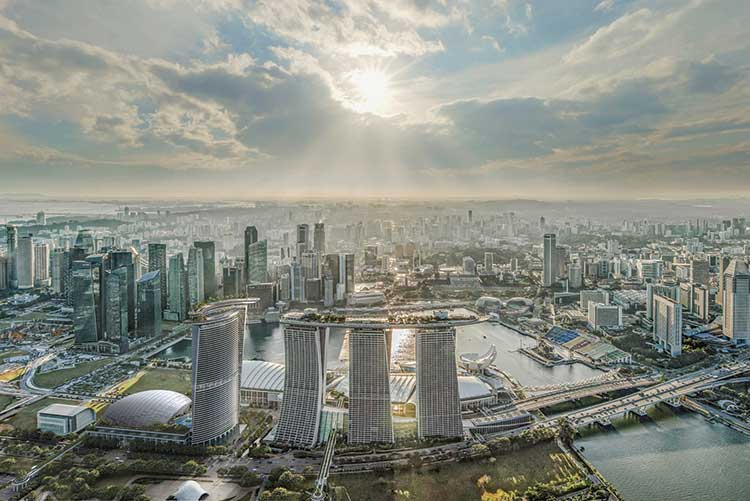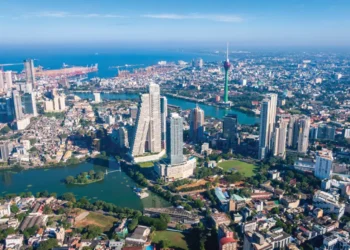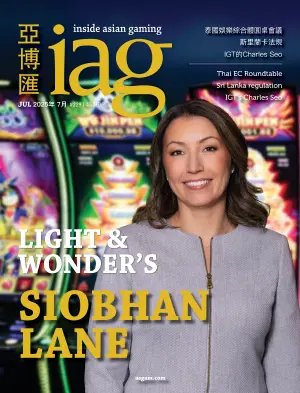As Singapore’s IR industry turns 10, Marina Bay Sands President and CEO George Tanasijevich explains why the iconic property has become the most profitable IR in the world.
With its 55 story triple towers and the world’s most famous rooftop pool, Marina Bay Sands (MBS) is an icon of Singapore, the most profitable property in the Las Vegas Sands portfolio, an industry flagship and object of envy from cities around the world.
MBS President and CEO George Tanasijevich has been there from the license bid and is overseeing a US$3.3 billion expansion beyond 2,500 guest rooms and 1.3 million square foot convention center, as well as adding a 15,000 seat arena and another rooftop pool.
With MBS turning 10 in April, Tanasijevich, also spearheading Japan IR efforts as LVS director of global development, looks back and ahead in this interview with IAG Editor at Large Muhammad Cohen (before the coronavirus outbreak impacted regional tourism).
Muhammad Cohen: What’s made Marina Bay Sands so successful?
George Tanasijevich: It was the right thing for Singapore at the right time. They gave us clear instructions and laid out objectives and goals that we were supposed to achieve, things we should align with. What they were hoping to achieve in this particular location is very consistent with the business model that we had pioneered that focuses on MICE and entertainment.
[Architect] Moshe Safdie came up with a spectacular design that was perfect for this particular site, one that captured the attention and the imagination of tourists and media and others all around the world, including governments in other locations. We work very hard to program Marina Bay Sands with the best that is on offer across all of the categories that are contained in this property.
With an integrated resort, you do massive amounts of planning and strategizing and programming the best that you can, and then you open your doors – and the customer starts to talk to you, and your job basically just starts all over again, because customer and tourist tastes change all the time. I think we’ve done a good job of keeping ahead of the customer and anticipating challenges and correcting mistakes and putting together an integrated resort designed and programmed for Singapore. We’ve positioned it to help the government and the people of Singapore achieve their economic tourism and labor market goals.
So we feel very fortunate to have had the opportunity to develop this project and are thankful for the level of collaboration and coordination that we have with the government, in particular, the Singapore Tourism Board and Casino Regulatory Authority.

MC: How does Singapore factor in?
GT: First of all, the opportunity was really quite attractive because of its downtown location on a site that is visible from 360 degrees, 20 minutes away from what is often described as the world’s greatest international airport. We’re situated on the edge of the CBD, quite convenient given that the MICE business is such a fundamental element of our business model.
We have very strong relationships, given our global footprint and our position and reputation within the industry, so that we can go out and bring in the great retailers, the great entertainment events, the cultural elements … the list goes on and on.
MC: It helps that Singapore is among the richest places on earth.
GT: It’s an upscale market that is positioned well to feature an upscale integrated resort. But I would note that even though Singapore is a very prosperous and successful country, not everybody is as well off as those that are depicted in certain contexts, [such as the novel/film] Crazy Rich Asians. As a result, we have an obligation to identify ways that we can contribute back to the community and focus on those who are less fortunate.
 MARQUEE ATTRACTION
MARQUEE ATTRACTION
MC: How does MBS make non-gaming so profitable while other Asian operators struggle with that?
GT: If you look across the property, you can see that we’ve programmed it with the most attractive non-gaming elements possible. You go through our retail mall and you see the lineup of the wonderful brands that we have. They’re set in a very interesting space, and we’re constantly looking for ways to improve the lineup. This constant pursuit of improvement is what drives us here. We are always looking for new entertainment options that we can put in the theater. We look for new opportunities to take a space that maybe isn’t achieving at a level that we had hoped and perhaps convert it to some other use.
We initially opened Marina Bay Sands with two Broadway style theaters. Over time, we recognized that we could probably fully program the theater component using just a single space. So we went to the government and sought permission to convert the other theater to a different form of entertainment use, which was a nightclub, upscale bar and a restaurant. We were able to convince the government that this would be a more productive use of the space and provide greater tourism appeal. It was a big step and a costly endeavor. But we think we made the property stronger and added something to Singapore, and quite frankly, Asia, that didn’t exist here before we opened, [nightclub] Marquee, [lounge] Avenue and [modern Japanese restaurant] Koma.
MC: On the flip side, how crucial is gaming as the economic engine of the IR?
GT: It’s very important. It contributes 70% to 75% of our revenue, and it positions us to underwrite the cost of things that have a lower return, or sometimes a negative return, or just things that are very expensive. For instance, the architecture that is featured at Marina Bay Sands, it’s very expensive to design and build something like that: there’s a reason why there’s only one SkyPark in the world.
[Gaming] allows us to invest in things like a museum or some aspects of entertainment that have a lower rate of return, and maybe wouldn’t make sense on a standalone basis. But when you package them up in an integrated resort format, it increases the overall attractiveness of the property, and it makes a lot of sense. The strength of the performance of the casino helps to position us to be able to invest in those kind of elements and then provide a wider range of attractions and amenities, which helps drive tourism to Singapore and customers to Marina Bay Sands.

MC: Growing gaming revenue, however, has proven difficult.
GT: It’s been pretty steady throughout our existence. We’re pleased that this kind of stability has been a constant in Singapore.
Over time, the profile of the customer and the mix of the customers has changed, but our people who run the casino operations are quite skilled at continuing to bring in strong and reliable customers who contribute to that piece of the business.
MC: What’s the impact of having no junket promoters at MBS?
GT: Marina Bay Sands is recognized as the most successful integrated resort in the world from a financial standpoint. We’ve been able to deal directly with customers in an appropriate way and establish a very strong business. So that hasn’t served to be a substantial handicap for us.
CONVENTIONAL WISDOM
MC: Why is MICE uniquely successful here?
GT: Singapore was already known globally as a great place to conduct MICE events. They had very strong facilities here, before we arrived, but what the government recognized – and this was quite visionary – is that even though they were strong in this area, they could get stronger. They recognized also that the most attractive MICE space for event organizers or delegates who attend those events is MICE space that is situated in an integrated resort because of everything that’s wrapped around it and the whole convenience factor. So we designed something that we thought was appropriate for this market.
Our Chairman Sheldon Adelson has been in the MICE industry for over 40 years in different areas of the business, and with his guidance and vision, we were able to put together a MICE facility that has been so popular that we are space constrained. As a result, we saw an opportunity to expand Marina Bay Sands to include additional MICE space, and fortunately we have been given that opportunity. I give credit to our team and to the strength of the business model for being able to make the MICE business so strong here.

MC: Let’s talk about the expansion.
GT: Since we opened, our annual occupancy rate in the hotel has ranged from 94% to 99%. That’s a signal to us that there’s more demand for our hotel rooms than we can satisfy. So we’ll build a hotel tower that has 900 to 1,000 rooms.
Every year we do around 70 exhibitions in our existing space, and we can’t do any more. So we need more exhibition space. Similarly, our ballroom is in high demand, and we’re not able to accommodate all of the business that comes our way. So the expansion project will have a significant ballroom in it.
In terms of entertainment, the largest music events that we can stage here right now, utilizing either our ballroom or the outdoor Event Plaza, are around 5,000 seats. We want to do more, but we want it to work economically. If you only have that many tickets to sell, it’s tough to cover your costs. The alternative within Singapore is the Indoor Stadium, but you can only sell about 9,000 or 10,000 tickets for those types of events at that venue. And the Indoor Stadium is highly programmed and difficult for promoters to get dates on the calendar.
So we’re looking to build an arena that will have over 15,000 seats. We think that will provide the opportunity for us to bring in more touring acts and have a greater component of entertainment events within our property. It will feature opportunities for corporate hospitality, which are largely absent from the existing Indoor Stadium. So we’re quite excited about introducing that to Singapore.
INVESTOR COMFORT
MC: Have IRs been successful for Singapore?
GT: If you look at the primary metrics that they identified in the beginning, such as increasing the number of foreign visitors and the amount that they spend when they’re here, the IRs have been a great success. I also think it’s had an impact on the reputation and the image of Singapore. The integrated resorts have provided comfort for potential investors here, whether it’s people who want to come in and set up a restaurant or some other type of entertainment venue with the increased tourism that has come here and the higher visibility of Singapore as a tourism destination. I think that has had a widespread impact on the market, and it’s been good for everybody.
 MC: Any downsides?
MC: Any downsides?
GT: The downside that was expected by some people before they understood what an integrated resort was or managing the risk that is often associated with a casino was that there was going to be an increase in the rate of problem gambling. In fact, the opposite has occurred. Since the integrated resorts have opened, not only has the proportion of the population that’s eligible to gamble decreased, but the rate of problem gambling has also declined [from 2.6% in 2011 to 0.9% in 2017].
That’s a lesson for all markets that are considering integrated resorts: while it may be counter intuitive that you offer a new opportunity for gambling as a form of entertainment in a market, and you can actually utilize that opportunity to bring down your rate of problem gambling. But you can utilize that opportunity to decrease problem gambling because the casino industry has the most highly evolved set of rules, regulations and laws that address problem gambling and that provide social safeguards to protect those who might be vulnerable. Other forms of gambling don’t bring that kind of infrastructure.
MC: What can other jurisdictions learn from MBS and Singapore’s IR experience?
GT: Singapore can serve as a case study or a benchmark. The fact that the introduction of casinos can lead to a decline in the rate of problem gambling is a very, very important lesson that can be learned. Other governments can look at how the regulatory structure has been established here, what changes have been made over time, how Singapore, when they implement a new measure, defines it in a very targeted way to make sure it specifically addresses any perceived problem. And other markets can gain comfort in knowing that there’s a way to do this right so that it can have a positive impact.
Another lesson that we’ve learned from the Marina Bay Sands experience is that great architecture can serve as a tourism draw in and of itself. With the advent of the smartphone and the popularity of the selfie, something like our SkyPark and the infinity edge pool has really been a strong attraction. We’ve been identified as the most Instagrammed hotel in the world, and people really just haven’t lost interest in coming and exploring the different, unique architectural elements of Marina Bay Sands. That’s really the first time in our industry that architectural design was emphasized to this extent, and the reaction has been very, very positive.
Then maybe one last lesson that can be learned is that the integrated resort format is really a tremendous vehicle to promote corporate social responsibility and to stage events that can support charities. We established our primary corporate social responsibility activity called Sands for Singapore. It started in 2013, and it’s raised some SG$27 million [US$20 million] since that point.
Its genesis stemmed from our recognition that we had two things that others who staged charitable activities don’t have: an employee base of 10,000 people, approximately, at a building that has so many different spaces and venues where you can hold events to support charitable activities that you just can’t find elsewhere. So what we wanted to do is come into this market and not just cut checks to support other charitable activities, which we still do to this day, but we wanted to find a way that we could contribute that others couldn’t.
 MC: [LVS President] Rob Goldstein questioned the wisdom of investing US$10 billion in an IR in Japan. What’s your reaction to that?
MC: [LVS President] Rob Goldstein questioned the wisdom of investing US$10 billion in an IR in Japan. What’s your reaction to that?
GT: You always have to ask yourself lots of questions when you’re considering any investment, particularly one of that magnitude. Japan is a very, very interesting and attractive market from the standpoint of an integrated resort operator. We have spent years traveling there and understanding the opportunity, and then also educating people in government and the private sector and community representatives.
As we start to see a bit more detail about where these opportunities might unfold, that’s when we can do a bit more study and planning. You’ve probably heard consistent comments from various companies throughout our industry talking about what the cost of entry will be, if you’re going to develop an IR in one of the major markets. It’s still the most exciting opportunity that we’re facing right now in our industry.
MC: With expansion, MBS is approaching US$10 billion invested.
GT: We’re US$5.6 billion on the original. This expansion is going to be US$3.3 billion minimum. Plus, we’ve put US$1.6 billion back into this property in terms of capex over the years.
The message you should take away from this is that when we go into a new market, we invest substantially, we look for new opportunities to expand our investment, and we are constantly putting money back into our existing facility to make sure that it’s fresh and competitive and is the best that we can offer our customers.


































